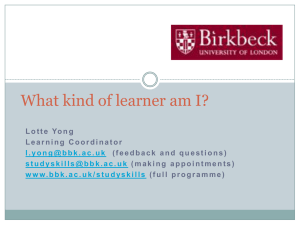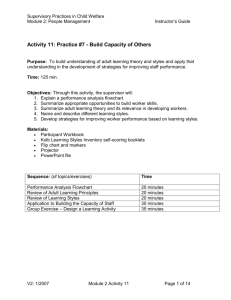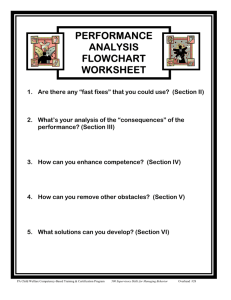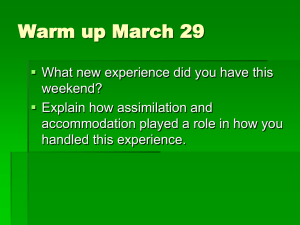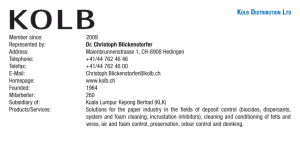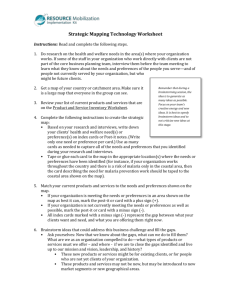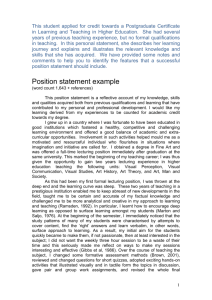Learn Continuously
advertisement
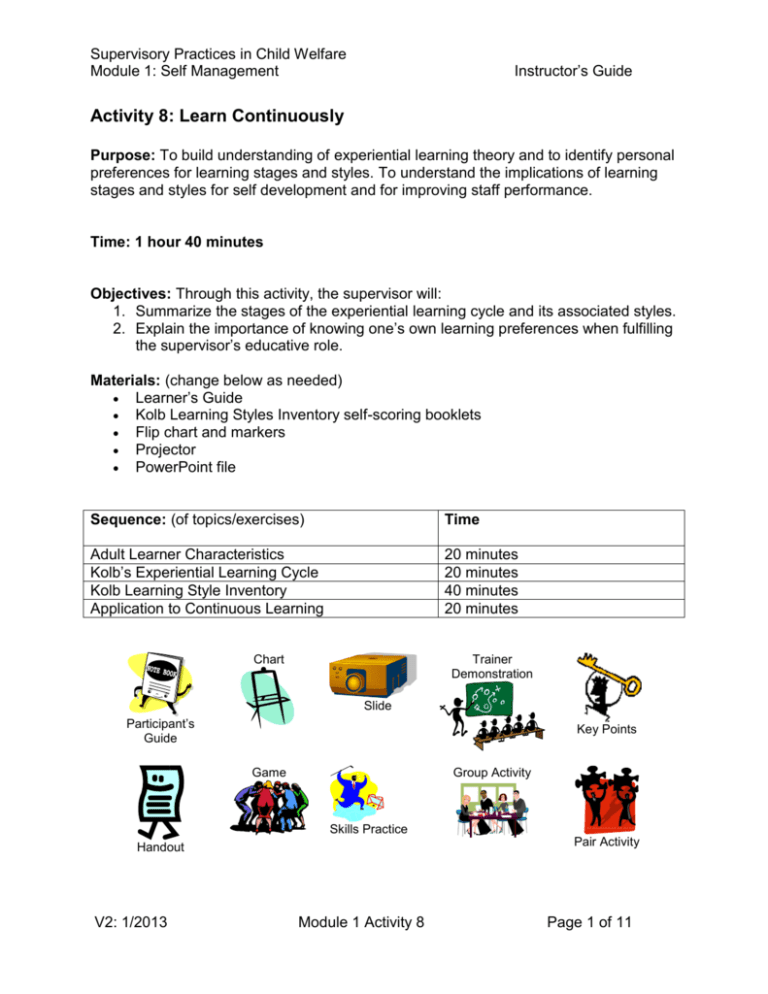
Supervisory Practices in Child Welfare Module 1: Self Management Instructor’s Guide Activity 8: Learn Continuously Purpose: To build understanding of experiential learning theory and to identify personal preferences for learning stages and styles. To understand the implications of learning stages and styles for self development and for improving staff performance. Time: 1 hour 40 minutes Objectives: Through this activity, the supervisor will: 1. Summarize the stages of the experiential learning cycle and its associated styles. 2. Explain the importance of knowing one’s own learning preferences when fulfilling the supervisor’s educative role. Materials: (change below as needed) Learner’s Guide Kolb Learning Styles Inventory self-scoring booklets Flip chart and markers Projector PowerPoint file Sequence: (of topics/exercises) Time Adult Learner Characteristics Kolb’s Experiential Learning Cycle Kolb Learning Style Inventory Application to Continuous Learning 20 minutes 20 minutes 40 minutes 20 minutes Chart Trainer Demonstration Slide Participant’s Guide Key Points Game Group Activity Skills Practice Pair Activity Handout V2: 1/2013 Module 1 Activity 8 Page 1 of 11 Supervisory Practices in Child Welfare Module 1: Self Management Instructor’s Guide Activity 8: Practice # 6 Learn Continuously (Total Time = 1 hr. 10 min.) Introduction: In this next activity, we’re going to explore adult learning. Each of you will assess yourselves to determine how you best like to learn. Then, we’ll talk about implications of this knowledge for your personal growth on the job, and for fulfilling your educative role as a supervisor. Adult Learner Characteristics – 20 minutes Ask: Do: Key Points V2: 1/2013 To frame your thinking, reflect on and tell me about some of your recent learning experiences. What did you learn? How did you learn it? What made you ready to learn? What barriers did you encounter? What did you do about them? Point out that their answers gives insight into the characteristics of adult learners. Post the characteristics on an easel sheet as you review them: Adult Learners are: Self Directed Experienced Goal Oriented Relevancy Oriented Practical Self-Directed: They need to be actively involved in the learning process. They should be given opportunity to take responsibility for their own learning. Experienced: Adults have accumulated a foundation of life experiences and knowledge that may include work-related activities, family responsibilities, and previous education. They need to connect learning to this knowledge/experience base. Goal Oriented: Adults know what they want to achieve in a learning situation. Module 1 Activity 8 This will be used again in Module 2 Page 2 of 11 Supervisory Practices in Child Welfare Module 1: Self Management Instructor’s Guide Relevancy Oriented: Learning has to be applicable to their work or other responsibilities to be of value to them. Practical: Adults are problem-solvers. Learning has to be helpful in solving work problems. They listen to the radio station WIIFM – What’s in it for me? Kolb’s Experiential Learning Cycle - 20 minutes Say: “Experience is a critical component of adult learning. “ The current model of adult experiential learning is attributed to David Kolb, Professor of Organizational Behavior in the Weatheread School of Management, Case Western Reserve University. It is the culmination of over 17 years of research and development. It is characterized by the following working definition of learning…” A Definition of Learning Slide #2 “Learning is the process whereby knowledge is created through the transformation of experience.” David A Kolb, Experiential Learning Mod 2 Act 11 2 Adult Learning Cycle Co n cr e t e Ex p e r i e n ce A ct i v e Ex p e r i m e n t a t i o n Slide #3 V2: 1/2013 Ob se r v a t i o n a n d Re f l e ct i o n A b st r a ct Co n ce p t u a l i za t i o n Mod 2 Act 11 3 Module 1 Activity 8 Page 3 of 11 Supervisory Practices in Child Welfare Module 1: Self Management Key Points Do: Key Points V2: 1/2013 Instructor’s Guide David Kolb (with Roger Fry) created his famous model out of four elements: concrete experience, observation and reflection, the formation of abstract concepts and active experimentation, (testing the concepts in new situations). It is unlike other one-dimensional theories of learning that focus only on behavioral or cognitive processes. It is a holistic, integrative model that combines experience, perception, cognition and behavior. Let’s review: Re-draw the adult learning cycle on the easel pad, one step at a time. Add the following words under each phase: “Experiencing and Feeling (encountering events); Observing and reflecting, Comparing and Concluding; and Applying and Adjusting.” Explain each element of the cycle. Provide examples of how the learning process builds on each stage of the cycle. The learning cycle can begin at any one of the four points It should really be approached as a continuous spiral. However, the learning process often begins with a person encountering an event in the real world – or carrying out a particular action. The person then notes and thinks about the effect(s) or results of the event or action. He may ask others what their thoughts are about it. The third step is seeking understanding of the general principles or truths that underlie the experience. The person seeks to understand the event and its results/effects by thinking about how it compares to similar past experiences. How does this fit with what I already know or believe to be true? This “generalizing” of results is the ability to see a connection between actions and effects over a range of circumstances, and Module 1 Activity 8 Note: Immediate or concrete experiences lead to observations and reflections. These reflections are then assimilated (absorbed and translated) into abstract concepts with implications for action, which the person can actively test and Page 4 of 11 Supervisory Practices in Child Welfare Module 1: Self Management Instructor’s Guide to identify the general principles that are at play across all of them. When the general principles are understood, the last step is to plan how to apply the principles in the next, related experience or event. While these steps are represented as a circular movement, the process is an ongoing spiral. Each time the action is taking place in a different set of circumstances and the learner is now able to anticipate the possible effects of the action. experiment with, which in turn enable the creation of new experiences Do Say: Review the cycle again with a concrete experience such as learning how to ride a bicycle; how to use a new cell phone; or how to use a new software. Whichever example you use, tell what’s happening at each stage of the cycle to transform the experience into knowledge. “David Kolb’s model is widely accepted as an excellent framework for planning, teaching and learning activities. Continuing the development of his model, Kolb isolated four major learning styles. These styles are grounded in the stages of the learning cycle that most attracts the learner. Just as we all have preferences for taking in and processing information, (visual, auditory, kinesthetic), we similarly have preferences for how we learn best. To understand the diversity of learners in your unit, it is helpful for you to first understand your own learning style and how it differs from the other three. To that end, and to enable us to have a conversation on each of the styles, you’ll now take out the Kolb Learning Style Inventory.” Kolb’s Learning Styles Inventory - 40 minutes Do: V2: 1/2013 Have participants take out the Kolb Learning Style Inventory Booklets. Have participants remove and complete the questionnaire. Module 1 Activity 8 Page 5 of 11 Supervisory Practices in Child Welfare Module 1: Self Management Have participants tally their scores. Explain that the numbers are associated with each phase of the experiential learning cycle. Explain what the distribution of numbers means. Ask and discuss their results, i.e. Were there any surprises? Do they think the results reflect their actual preferences for one or more of the stages? Have participants plot their results on pg. 3 of the booklet to identify their learning style preference. Review the information “Identifying your Preferred Learning Style Type” on pg. 5 of the booklet. This page compares the shape of the participants’ “kite” with the phase of the learning cycle that they prefer. Each of the four learning styles combine preferences for two stages of the Experiential Learning Cycle. The Diverging style is a preference for experiencing events and reflecting on them. Also, hearing what others have to say about them. The individual with this learning style will benefit from discussion sessions when different points of view and/or experiences are shared. Explain Key Points V2: 1/2013 Instructor’s Guide The Assimilating style is a preference for pulling all of the various points of view into a unified, logical conclusion about the event under consideration. The person who has this style likes making sense out of an experience by coming up with “rules” or ideas about how things work. The Converging style is a preference for taking those logical conclusions or rules about how stuff works, and making a plan for future action based up on what was learned. The Accommodating style is a preference for carrying out the plan of action, and making adjustments to it to fit each new situation as encountered. Module 1 Activity 8 Page 6 of 11 Supervisory Practices in Child Welfare Module 1: Self Management Do Instructor’s Guide Answer any questions they may have about the styles. Turn the conversation to what it means for performing their educative role with staff. Application to Continuous Learning – 20 minutes Ask & Discuss Key Points Why is it important for you to understand your learning style preferences? As a supervisor, your educative role is to develop your staff by helping them learn how to be effective in doing their job. Creating an atmosphere of continuous learning focused on the way adults learn best will enhance the performance of your workers. Like you, they will have preferences for how they learn best. Pre-post this question on an easel sheet. If you are unaware of the differing styles, and unaware of your own style and preferences, you may mistakenly impose them upon workers who learn differently from you. You may then assume that they are “not getting it” because of some defect they possess, rather than because of the way you are insisting they learn it. Ask& Discuss Say V2: 1/2013 How will understanding your own learning style preferences help you grow in performing your job? In order to “Learn Continuously” you first have to understand the stages of the experiential learning cycle, and the learning styles and preferences associated with it. Module 1 Activity 8 Pre-post this question on an easel sheet. Page 7 of 11 Supervisory Practices in Child Welfare Module 1: Self Management Key Points Instructor’s Guide Knowing your own preferences will help you understand why you may not like, or may struggle with, certain stages of learning. It also will help you be mindful that your workers have their own unique preferences, and you must not impose your preferences upon them. Furthermore, while adults have preferences for some sections of the cycle, ultimately all phases must be passed through for learning to take place. Therefore, it is important to ensure that you provide opportunities for the various stages of the cycle to occur – both for yourself, and with your workers - when taking steps to build skills. We will talk more about experiential learning and designing learning activities to improve your worker’s performance in Module 2 of this program. Say Trainer Demonstration Do: V2: 1/2013 To conclude our discussion on experiential learning, let’s do a quick, fun exercise that illustrates the cycle. Add it up exercise. Tell participants you are going to ask them to add cumulative totals for a column of whole round numbers. Provide an example, saying if the first number were 10 and the second fifteen, they would say 25. If the next number were 5, they would say 30. Before displaying the problem on easel, cover up all the numbers except the first number (1,000) so no one can see the rest of the numbers. Tell participants to add up the numbers cumulatively and to do so aloud and simultaneously. Module 1 Activity 8 Pre-print the following on an easel pad: 1,000 40 1,000 30 1,000 20 1,000 10 _____ 4,100 Page 8 of 11 Supervisory Practices in Child Welfare Module 1: Self Management Tell them to start with the first number they see. After they have said “one thousand” reveal the next number (40) and encourage them to add it to the 1000 and give the answer out loud. They should be able to continue without any further prompting Continue revealing one number at a time, pausing slightly before revealing the last number (10). Do not reveal the answer yet. When learners start to say an answer, there is usually hesitation, and someone will yell out 5,000. Gasps will begin when they see the correct answer. Only a small percentage will call out the right answer Say: Ask: Say: You’ve just experienced an event in the real world – What phase of the learning cycle is that? So, what happened during the experience that so many of you got the answer wrong? What did you do? What did you think about? You’ve just spent some time in which stage of the experiential learning cycle? V2: 1/2013 Instructor’s Guide Fold the bottom up to cover all but the first number (1,000) Concrete Experience You created a pattern of thousands… (1,000, 2,000 3,000 4,000 5,000) just as if you were adding numbers 1-5. This process yields an unjustified confidence in anticipating the next response. Reflective Observation You have heard others share their reactions and thinking about the experience. You have reflected on your own behavior and why you got the right or wrong answer. Module 1 Activity 8 Page 9 of 11 Supervisory Practices in Child Welfare Module 1: Self Management What did you conclude from this experience? Note we often succumb to our security needs or conditioning and stay with the same old way of responding. Most people could total the numbers correctly if they were presented with all the data at once. Instead, I forced you into a patterned response that is difficult to break. Relying on patterned responses without thinking more carefully can lead us astray in some contexts or circumstances. Optional: You can ask participants to discuss other examples of this behavior in their lives. What stage of the learning cycle have we just now completed? Abstract Conceptualization So what action can we put into place the next time we encounter a thinking exercise like this in the future? What other future circumstances can we apply that plan of action? What might the result be? Provided with the exact same activity, you would do things differently to get an accurate result. You would take more caution to examine your thinking process as you were adding the numbers. And remembering the lessons learned from this exercise – you may generalize the learning to new, novel experiences. You may begin to check your thinking more carefully before jumping to conclusions. What stage of the learning cycle will we be completing the next time we apply our conclusions to a thinking exercise? Our focus on understanding and managing yourself before you can effectively manage others has covered a number of areas: transitioning to supervisor; cultural selfawareness; our use of time; and our preferences for how we learn. Ask Say Ask: Ask: Say Ask: Transition V2: 1/2013 Instructor’s Guide Module 1 Activity 8 Active Experimentation Page 10 of 11 Supervisory Practices in Child Welfare Module 1: Self Management V2: 1/2013 Instructor’s Guide To be effective as a supervisor in a childserving system, there’s one other area we must look at in self-management: How we commit ourselves, our energies and our time to the mission, vision and values of DCF, and to the children we serve. Our next activity will explore these concepts. Module 1 Activity 8 Page 11 of 11
